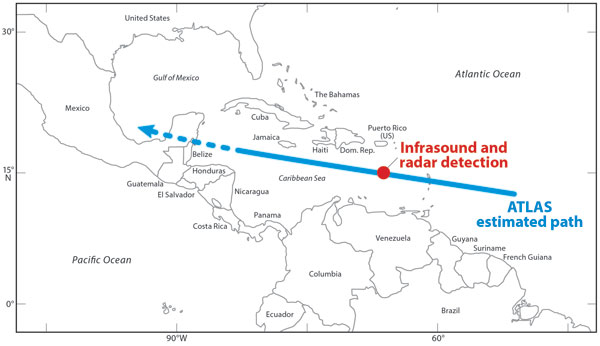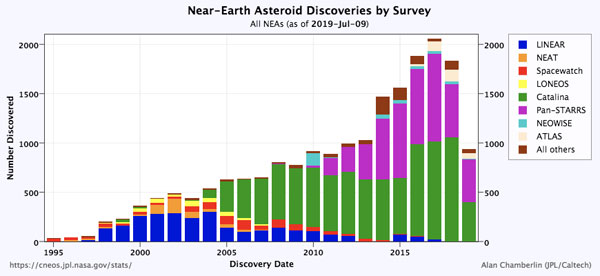Discoveries include a near-Earth asteroid with the shortest “year” and another found hours before it burned up in Earth’s atmosphere.
Finding and keeping track of near-Earth asteroids has become a top priority over the past few decades. And scientists have largely succeeded, cataloging more than 90% of kilometer-size or bigger rocks that come within 50 million kilometers (30 million miles) of Earth.
But there are far more smaller asteroids out there than big ones, and while they won’t cause extinction-level events, they can still cause significant damage. The Chelyabinsk meteor blast in 2013 damaged thousands of buildings and its blast exploded glass windows that injured some 1,500 people. Much of this smaller population of space rocks remains undiscovered, so astronomers have dedicated several telescopes to spotting the faint and fleet movements of nearby asteroids as they cross the sky. And those telescopes are striking it rich.
The Shortest Year
The sky-surveying camera known as the Zwicky Transient Facility caught an asteroid that laps around the Sun in only 151 days. The object travels on an elliptical track that takes it from farther out than Venus to closer than Mercury.

NASA / JPL-Caltech
Credit: NASA/JPL-Caltech
The asteroid, designated 2019 LF6, is roughly a kilometer in size, but it evaded detection until now because it’s a member of the so-called Atira asteroids, whose orbits fall inside Earth’s. There are only 19 other Atira asteroids known. They’re difficult to spot because their close-in orbits mean they’re only visible during twilight hours: 20 to 30 minutes after sunset or before sunrise.

ZTF / Caltech Optical Observatories
2019 LF6 is also unusual because of its large inclination angle — its orbit takes it well outside the plane of the solar system. Perhaps in the past it had a gravitational fling with Mercury or Venus.
The Zwicky Transient Facility has already found about 100 other near-Earth asteroids since it started science observations earlier this year.
Asteroid Incoming
Another two asteroid-hunting telescopes, the Asteroid Terrestrial-impact Last Alert System (ATLAS) and the second Pan-STARRS telescope (PS2), worked together to find and calculate the entry path of a tiny, 4-meter space rock that ultimately burned up in Earth’s atmosphere.
The two Hawai‘i-based telescopes of ATLAS have discovered more than 300 near-Earth asteroids since the first telescope was fully deployed in 2015; a second telescope joined the first in 2017. The tally includes more than 30 potentially hazardous asteroids, whose orbits cross Earth’s. The asteroids ATLAS is designed to find are smaller — they’ll be discovered too late to deflect, but early warning of their arrival will allow evacuation of target areas.

Larry Denneau (IfA / ATLAS), Brooks Bays (SOEST)
ATLAS discovered its newest asteroid, designated 2019 MO, in the early morning hours of June 22nd. The space rock was initially given a modest impact rating of 2, but that was upgraded to a “likely” impact rating of 4 when astronomers located the asteroid using additional observations with PS2, located atop Haleakalā in Hawai‘i. Twelve hours later, the Nexrad weather radar in San Juan, Puerto Rico detected the low-frequency sound waves produced when the asteroid burned up in the atmosphere over the ocean.

RAMMB / CIRA / Colorado State University
The Zwicky Transient Facility, ATLAS, and Pan-STARRS 2 are among the facilities leading the charge in finding near-Earth asteroids, including potentially hazardous ones. The other big hitter is the Catalina Sky Survey, which is still going strong: it found more than 1,000 near-Earth asteroids in 2018 alone. But space is big and the sky is still crawling with undiscovered asteroids — these telescopes have their work cut out for them.

CNEOS / NASA
 0
0









Comments
You must be logged in to post a comment.